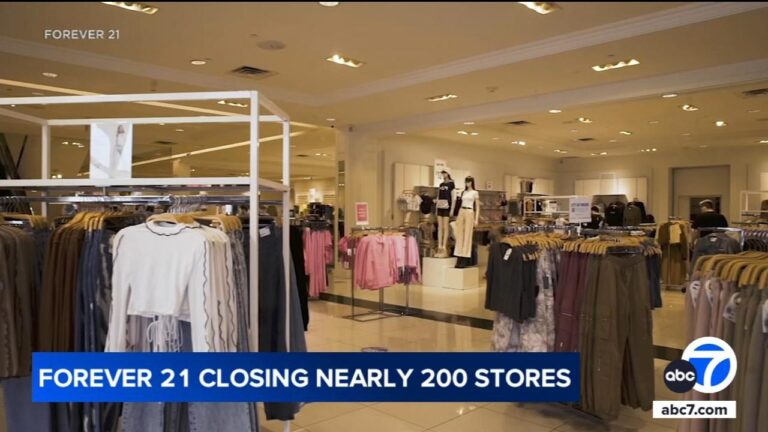Forever 21 to Exit U.S. Retail Market Completely by May
Forever 21, a trailblazer in affordable fast fashion, is preparing to close all 354 of its stores across the United States by May, as reported by KSAT. This decisive action signals the conclusion of a significant chapter for the brand that once dominated youth fashion with trendy, budget-friendly apparel. The closures reflect mounting financial pressures and evolving consumer habits, underscoring a transformative period in the retail sector.
Highlights of the closure plan include:
- Complete shutdown of all U.S. physical stores by early May
- Strategic pivot towards expanding online sales and international markets
- Potential economic repercussions for landlords and local business ecosystems
| Metric | 2023 Data | 2024 Projection |
|---|---|---|
| Number of U.S. Stores | 354 | 0 |
| Annual U.S. Revenue | $1.2 Billion | $0 from physical stores |
| Employees Impacted | Approximately 5,000 | Support and transition programs underway |
Employee and Community Repercussions of Store Closures
The impending shutdown of Forever 21‚Äôs entire U.S. retail footprint will deeply affect thousands of workers who rely on these outlets for employment. Industry experts estimate that between 10,000 and 15,000 employees‚ÄĒranging from sales associates to store managers‚ÄĒmay face job losses. Many of these individuals are part-time workers, students, or those seeking flexible schedules, amplifying the economic uncertainty in their communities.
Local economies, particularly in suburban shopping centers and smaller towns where Forever 21 served as a key retail anchor, are also poised to feel the impact. The closures could trigger:
- Declines in foot traffic, adversely affecting neighboring retailers
- Reduced rental income for commercial property owners
- Increased vacancy rates, potentially diminishing the vibrancy of shopping districts
| Affected Area | Likely Consequences |
|---|---|
| Workforce | Widespread layoffs and job insecurity |
| Local Retailers | Drop in customer visits and sales |
| Commercial Real Estate | Higher vacancy rates and downward pressure on rents |
Underlying Retail Trends Driving Forever 21’s Decline
Forever 21’s initial rapid growth capitalized on the fast fashion boom, but the brand struggled to evolve alongside shifting consumer values and technological advancements. The surge of e-commerce powerhouses and digitally native brands with nimble supply chains starkly contrasted with Forever 21’s slower, traditional retail approach. Additionally, the brand faced fierce competition from both luxury and budget fashion players. Increasing consumer awareness about environmental sustainability further dampened demand for fast fashion’s disposable clothing model.
Key factors contributing to Forever 21’s downturn include:
- Consumer migration from brick-and-mortar stores to online shopping, with Forever 21 lagging in digital innovation
- Growing demand for ethically sourced and eco-friendly apparel
- Intensified rivalry from agile, trend-responsive online brands
- Overextension resulting in costly operations and underperforming outlets
| Trend | Effect on Forever 21 | Industry Adaptation |
|---|---|---|
| Digital Evolution | Delayed enhancement of online shopping experience | Investment in omnichannel retail and mobile platforms |
| Sustainability Awareness | Brand image challenged by fast fashion’s environmental impact | Shift toward sustainable fabrics and transparent sourcing |
| Changing Consumer Habits | Reduced in-store visits and impulse buying | Focus on personalized marketing and loyalty incentives |
How Shoppers and Investors Can Navigate the Shifting Retail Landscape
With Forever 21‚Äôs U.S. stores closing by May, shoppers should seize the opportunity to benefit from clearance sales offering substantial discounts on trendy apparel. Prioritizing versatile, timeless wardrobe essentials can ensure lasting value beyond the brand‚Äôs exit. Additionally, the secondary market‚ÄĒsuch as online resale platforms‚ÄĒmay become a valuable resource for acquiring popular Forever 21 items after store closures, as scarcity drives demand.
For investors and market analysts, this development highlights the ongoing transformation within the fast fashion sector. Diversifying portfolios to include emerging sustainable brands and technology-driven retailers can help mitigate risks tied to traditional mall-based businesses. Below is a summary of strategic recommendations for key stakeholders:
| Stakeholder | Recommended Approach | Anticipated Benefit |
|---|---|---|
| Consumers | Take advantage of final markdowns; focus on essential pieces | Maximize savings and build a durable wardrobe |
| Investors | Shift investments toward e-commerce and sustainable fashion brands | Lower risk exposure and tap into growth markets |
| Retail Analysts | Track evolving consumer spending and retail innovations | Enhance forecasting accuracy and strategic insights |
Looking Ahead: The Future of Forever 21 and Retail
The complete closure of Forever 21’s U.S. stores marks a pivotal moment for the fast fashion industry. As the brand transitions away from physical retail, stakeholders will be watching closely to see how Forever 21 reinvents itself in the digital and international arenas. Meanwhile, employees and customers face a period of adjustment amid this significant shift. This development underscores the broader evolution of fashion retail, where adaptability, sustainability, and technology increasingly dictate success.




